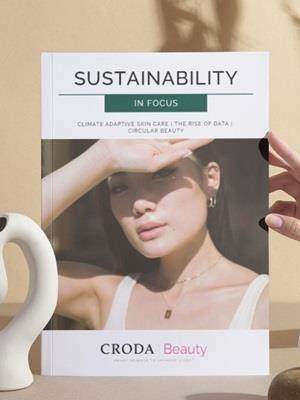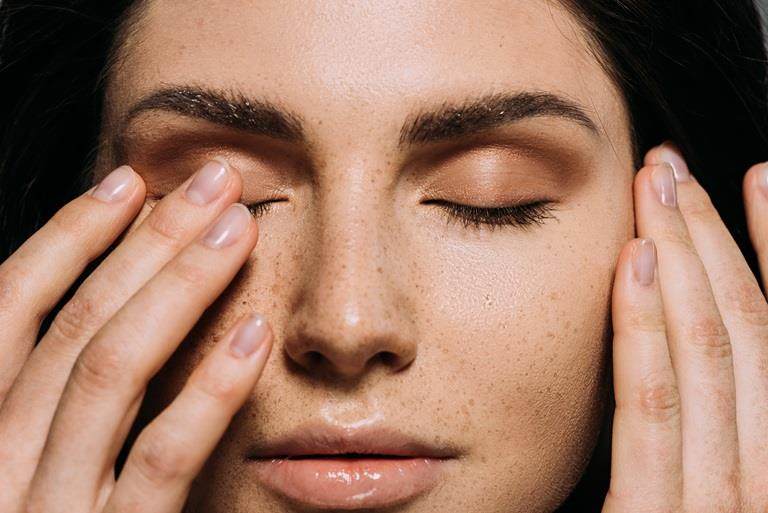What's hot in sustainability? Insights from the beauty market for 2026 and beyond

1. Climate adaptive skin care: climate-conscious beauty for a changing world
Climate adaptive skin care is a movement rooted in the recognition that skin health is inextricably linked to environmental conditions and is one facet of the overarching climate adaptive beauty concept. Consumers today are contending with intensified UV exposure, shifting humidity patterns, rising pollution levels, and temperature volatility - all of which affect skin function and appearance.
This has sparked demand for climate adaptive skin care, with versatile products able to meet changing geographic and seasonal stressors.
What’s driving the shift?
Extreme weather, urban pollution, and rising consumer literacy around environmental stressors are making consumers rethink what "effective skin care" really means. Over the past few years, skin care has pivoted from a focus on beauty and anti-ageing to resilience, with no signs of going back(1).
The trend is being further fuelled by global travel, urban living, and a growing awareness of skin health in the face of this environmental volatility(2). Shoppers are also becoming more skin-savvy; researching ingredients and supply chains to identify the products that can keep up with their rapidly evolving environment and busy lives.
What are we seeing in the market?
The industry is beginning to respond with globally-focused R&D and smarter product positioning. Some examples include:
- Formulation strategies: Leveraging antioxidant complexes, anti-pollution shields, and adaptogenic botanicals that address both specific local conditions (e.g., arid vs. humid climates) as well as an environment that is in a constant state of flux.
- Geo-targeted marketing: Product lines increasingly organised by climate zone rather than skin type alone, such as “urban defence” serums or “tropical hydration” cleansers.
- Data-driven design: Integration of Product Carbon Footprint and Life Cycle Assessment using verified methodologies (e.g. Product Environmental Footprint (PEF) 3.0) ensures not only that products perform under stress, but also that their production doesn’t contribute further to environmental harm.
- Ingredient responsibility: Shifts toward biodegradable, traceable, and ecologically resilient raw materials that align with climate adaptive skin care’s low-impact ethos.
The future outlook
Climate adaptive skin care is poised to become a norm rather than a niche, with health, wellness, and beauty becoming increasingly interconnected. The market for climate adaptive skin care products is expected to grow at a compound annual growth rate (CAGR) of 14.3% from 2025 to 2034, with hot/humid market segments dominating the category(2).
As climate change intensifies, skin care brands will further invest in advanced formulations that include environment-sensing ingredients, thermo-responsive systems, and AI-powered personalisation tools. These innovations enable products and routines to adapt in real time to changing conditions, offering tailored protection and hydration.
Feeling inspired?
Discover our range of environment and pollution protection formulations here, or view some of the highlights below.
2. The Rise of Data: Turning Metrics into Momentum
Gone are the days when sustainability claims could be vague or unverifiable. Today, data isn’t just support - it’s strategy. Heightened scrutiny from both regulators and consumers is pushing brands to quantify their impacts with precision, becoming central to credibility, compliance, and competitiveness.
What’s behind the rise?
With legislation like the EU’s potential Green Claims Directive tightening standards around environmental marketing, brands must now substantiate claims with hard data or risk penalties. Downstream, greenwashing fatigue has given way to a new demand: show, don’t tell. Consumer expectations are shifting as shoppers search for quantifiable proof of sustainability.
Improved technology maturity has pushed tools that once felt experimental, like Product Carbon Footprint (PCF) calculators, into robust sources of truth. With the potential for greater data transparency, major retailers and buyers are increasingly asking for impact data as part of procurement and reporting.
In essence, data is becoming the currency of trust - both B2B and B2C.
What are we doing with it?
Forward-thinking brands are embedding data collection, analysis, and communication into every part of the product lifecycle. Here's what that looks like in action:
- Product Carbon Footprints (PCF): Used to calculate and communicate greenhouse gas emissions at the product level – usually from raw material extraction to the manufacturer’s gate. Leading companies are leveraging this to benchmark SKUs, identify hotspots, and guide reformulation. At Croda Beauty, we have more than 1,550 Cradle-to-Gate PCF statements available for our products, helping our customers embed carbon considerations into their formulation.
- Life Cycle Assessment (LCA): This more holistic tool incorporates carbon, water, energy, and biodiversity metrics to paint a fuller picture of environmental impact. Croda Beauty’s LCA methodology follows PEF 3.0 and incorporates 16 key indicators to provide a comprehensive overview of our product environmental footprint.
- Biodegradability data: Brands are increasingly testing and publishing how fast and fully their ingredients break down in nature, responding to concern about persistent chemicals. Find details of our product biodegradability using our Product Finder.
- Smart labelling and QR code integration: Letting consumers scan to access ingredient sourcing, sustainability scores, and performance data in real time.
- Supplier data onboarding: Integrating emissions and sustainability metrics from across the supply chain to inform buying decisions and increase traceability.
The most progressive industry players are not just collecting data; they’re operationalizing it to shape innovation, track progress, and speak with confidence about impact.
Looking forwards…
Ultimately, the rise of data isn’t about turning sustainability into a spreadsheet - it’s about empowering smarter decisions, building meaningful trust, and holding ourselves accountable to the future we claim to champion.
Brands that can articulate and operationalize their emissions and impact profiles will be better equipped to reformulate with proactive, responsible design for a low-carbon future and win trust while doing so.

3. Circular Beauty: Redesigning for a regenerative future
Circularity is evolving from concept to commercial reality as the industry recognises that a linear “take-make-waste” model is no longer compatible with planetary boundaries or consumer values.
From refillable formats to full product lifecycle redesign, brands are getting serious about rethinking resource use and the consumer narrative is shifting from “more” to “enough.”
What’s fuelling the rise?
As non-renewable raw materials and fossil fuels grow scarcer and more expensive, economic, sourcing, and environmental risks are becoming apparent for brands. Circularity helps to decouple economic activity from finite resources(3), offering the opportunity for extended material use through reuse, recycling, and responsible regeneration.
There is also a growing rejection of overconsumption and disposability, with shoppers rallying around refillable, reusable, and low-impact products. With consumer behaviour shifting in favour of sustainability, as well as increased innovation and funding into greener technologies, the green premium is expected to diminish(4), making sustainable options even more competitive.
Frameworks like Cradle-to-Cradle and B Corp are also gaining popularity and awareness, providing brands with independently verified tools to assess and embed circularity in product development, not just marketing.
How are brands responding?
Brands are responding with tangible strategies to reduce virgin resource use and minimise end-of-life waste:
- Refill and reuse systems: From luxury skin care in glass pods to drugstore shampoos in soft pouches, the refill economy is scaling fast, as are packaging-free formats.
- Water-efficient formulation: Bars, balms, powders, and concentrates can be a more sustainable format for formulations that require minimal water in development. Rather than adding water to offer a liquid format, function can be delivered with less bulk; ultimately cutting impact in areas like transport emissions and water scarcity. Alternatively, consider how rinse-free formulations could help to save water and energy during the use-phase, cutting downstream impacts.
- Sourcing for sustainability: Many companies are considering the origin of their ingredients and embedding sustainability considerations into their supply chain - such as seeking sustainably farmed raw materials or utilising innovative technologies like plant cell culture - to reduce environmental impact and ensure traceability. Some are also using waste streams from other processes or even industries in place of virgin raw materials, minimising waste and, in some cases, costs.
The common thread? Circularity isn’t just a sustainability play; it’s an innovation driver.
What to look out for in 2026 and beyond
The future of circularity lies in scalability, integration, and accountability. Embedding sustainability considerations early into the design process, with help from transparent supplier data, will bolster innovation and result in smarter, more sustainable products.
Beauty brands may join forces with fashion, food, or tech to create shared refill infrastructure and material ecosystems. Expect more Extended Producer Responsibility schemes to emerge as policy makers push for climate action, making brands financially and legally responsible for their waste.
With further cultural shift, “newness” will switch to “longevity” as the primary metric of value. Circularity will start to reshape aesthetic trends and consumer expectations -from minimalist design to modular functionality.
Ultimately, circularity challenges the industry not just to do less harm, but to actively design for regeneration.
Final Thoughts: From Trendspotting to Strategic Action
These three trends underscore a deeper truth: sustainability is becoming more systemic, data-driven, and consumer-aligned. For brands, this means creating resilient business models that reflect a changing planet and a conscious customer base.
So, what are brands doing right now with these trends and what do you need to know to excel in the market? Review our companion piece, Sustainability in Focus, for the full market context, including examples from brands and ingredient inspiration for your next formulation.
Sustainability In Focus

References
(1) Avon (2024) Future of Beauty Report 2024
(2) Insight Ace Analytics (2025) Global Climate Responsive Beauty Products Market Research Report
(3) Ellen MacArthur Foundation (2025) What is a circular economy?
(4) Trends Research and Advisory (2025) Evaluating the Green Premium: Challenges and Opportunities in the Transition to Sustainable Energy Solutions.



